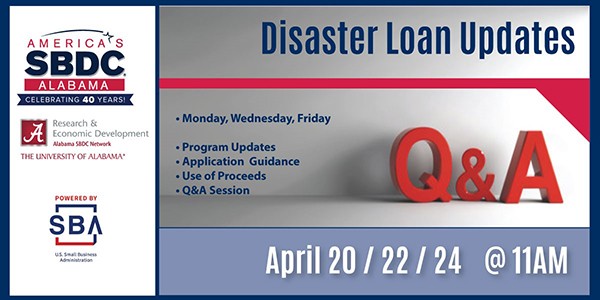Disaster Loan Funding Update
Disaster Loan Funding Update
If you follow us on Facebook, you know that over $4.8 billion in PPP loans were approved for 27,922 companies in Alabama. We think that is... a good start. According to SBA statistics, there are almost 400,000 small businesses in Alabama, accounting for 47% of the state's employment. Based on news reports today (4/19), it looks like an additional $300 billion is on the table for PPP, and $50 billion for the SBA Disaster Loan.
If you haven't submitted an application yet, please be prepared to do so when banks and SBA begin accepting applications again. If you're new to this, our On-Demand webinar is a good place to start.
Disaster Loan FAQ
Over the last month, we have hosted almost-daily webinars on the various disaster loan programs, and fielded thousands of questions from concerned small business owners.
We've compiled our responses to the most frequently asked questions.
Q&A Webinars: Mon/Wed/Fri @ 11am
After a 10-15 minute update, we will focus on questions from participants.
Disaster Loan Status?
You submitted an application a while ago - and you did it through the correct website, but no one has contacted you.
How can you check on the status of your SBA Disaster Loan?
1. Check your personal credit report. When you application is being reviewed by a loan officer, they will check your credit. If you see that your credit was pulled, it likely means that SBA is working your application.
2. Call the help line, but be prepared to wait. Call 1-800-659-2955
Coming Soon
We're partnering with the Alabama Restaurant & Hospitality Association (ARHA) to present training to one of the most heavily-impacted sectors of our economy: restaurants, hotels, and tourism.
Learn more about ARHA, and their Workers Relief Fund at https://www.arhaonline.com/

Main Street Lending Program
While we expect the PPP and EIDL programs to receive additional funding, many businesses have started evaluating other options. One new initiative, the Main Street Lending Program, may be a fit for some small businesses. Even if you have taken advantage of other disaster programs, firms will still be eligible to participate in this program.
• The interest rates borrowers can expect to pay on Main Street loans are variable and right now range from 2.5 percent to 4 percent. The PPP loans offer a 1 percent fixed interest rate.
• The repayment term for Main Street loans is four years. PPP loans have two-year terms.
• Currently, the smallest loan amount for Main Street loans is $1 million. (Banker associations have asked the Federal Reserve to lower that threshold to $50,000 to $100,000.) There's no minimum loan amount for PPP loans. There are upward limitations on both programs, however. For PPP loans, the maximum loan amount is $10 million. Main Street loan sizes vary based on which Main Street Lending facility for which you apply. There are two: one for new loans and one for borrowers who have an existing loan through a given lender.
• While PPP loans may be fully or partially forgiven if companies apportion at least 75 percent of their loan proceeds to pay employees' salary, rent, and some utilities, Main Street loans may not be forgiven.
• To be eligible, companies need to have at least $250,000 in earnings before interest, taxes, depreciation, and amortization (EBITDA) and no debt. Companies with debt have higher EBITDA requirements.
NOTE: Much like the launch of the Paycheck Protection Program, much of the information surrounding the deployment of the Main Street program should be considered preliminary. Operating parameters are subject to change.
That's A Good Question...
Despite the sometimes vague or incongruent guidelines published by Treasury and SBA, the SBDC team has been able to immediately answer most of the questions asked during the webinars. When there is no clear answer, we are quick to state that fact - and then provide our best guidance. When the questions can't be answered live, the SBDC CAP team responds by email as quickly as possible. Here's an example of a good question that we had to answer off-line, to get the details right:
QUESTION: I have someone out under emergency FMLA and is in the 3rd week of receiving 2/3 of her pay. Can I pay her for 8 weeks under PPP and then go back to emergency FMLA if she is still under doctor’s orders to self-quarantine after the 8 weeks of PPP?
ANSWER: Whether the employee can take Emergency Leave wages intermittently depends on (1) the reason they’re taking the leave (sounds like doctors orders) and (2) if they can telework. If the employee can telework, they can take intermittent leave (meaning the employee and the employer can work out a schedule where they may work every other day, and take leave the remaining days, or work half days and take leave for half days, etc.).
If the employee cannot telework, and they are under doctor’s orders to self-quarantine, they cannot take intermittent leave. The employee must use the leave until they run out or they are no longer under doctor’s orders. If they can get back to work before they actually run out of sick leave, they can use any leftover sick leave if needed at a later date.
The employer can, if they want, pay the employee more than the FFCRA requirement for emergency leave, and include the extra in the payroll costs portion of the PPP. However, they cannot include the emergency leave wages (the 2/3 pay) that they take a credit for in either the average payroll cost calculation or in the forgiveness calculation.

